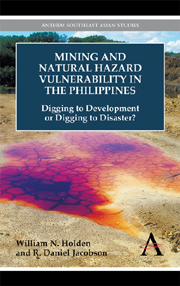 Mining and Natural Hazard Vulnerability in the Philippines
Mining and Natural Hazard Vulnerability in the Philippines Book contents
- Frontmatter
- Contents
- Acknowledgments
- List of Tables and Figures
- List of Acronyms
- Introduction
- Chapter One Mining in the Philippines
- Chapter Two Government Efforts to Encourage Mining
- Chapter Three Environmental Effects of Mining
- Chapter Four Mining amid Natural Hazards
- Chapter Five Technocratic Responses to the Risks
- Chapter Six Risk Society in the Philippines
- Chapter Seven Mining as a Flawed Development Paradigm
- Chapter Eight Is Another World Possible?
- Conclusion
- Bibliography
- Index
Chapter Three - Environmental Effects of Mining
Published online by Cambridge University Press: 05 May 2012
- Frontmatter
- Contents
- Acknowledgments
- List of Tables and Figures
- List of Acronyms
- Introduction
- Chapter One Mining in the Philippines
- Chapter Two Government Efforts to Encourage Mining
- Chapter Three Environmental Effects of Mining
- Chapter Four Mining amid Natural Hazards
- Chapter Five Technocratic Responses to the Risks
- Chapter Six Risk Society in the Philippines
- Chapter Seven Mining as a Flawed Development Paradigm
- Chapter Eight Is Another World Possible?
- Conclusion
- Bibliography
- Index
Summary
Mining: An Activity with Substantial Potential for Environmental Harm
The government of the Philippines is counting on the role mining can play as a source of economic development, but it must be acknowledged that mining is also an activity presenting a plethora of environmental, social and economic problems. As Pring et al. (1999, 45) acknowledged, “Few, if any, forms of economic development present the array of potential environmental, social and economic problems of the mining industry.” Discovering, extracting and processing minerals is widely regarded as one of the most environmentally and socially disruptive activities in the world and environmental impacts can occur during exploration, mine development, mine operation and long after a mine has closed down (Bebbington et al. 2008). Modern large-scale mining can alter landscapes, water systems, economies and communities, often permanently (D'Esposito 2005).
Mining's Visual Impacts
The most obvious (and arguably least serious) impact of mining is its visual, or aesthetic, impact. “To conservationists,” wrote Francaviglia (2004, 40), “mining landscapes seem a nightmarish expression of technology run amok.” “Visually, mining produces some of the most dramatic landscapes on earth” (Francaviglia 2004, 42). In developed countries it is common for mining projects to be objected to because they are seen as industrial blight upon the landscape; surface disturbance, dust and vegetation removal all contribute to a general unsightliness of the landscape (Ripley et al. 1978).
- Type
- Chapter
- Information
- Mining and Natural Hazard Vulnerability in the PhilippinesDigging to Development or Digging to Disaster?, pp. 59 - 76Publisher: Anthem PressPrint publication year: 2012


